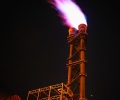S China’s power utilities curb ops, review gas procurement on high LNG prices

High spot LNG prices and low margins have prompted southern China’s gas-fired power plants to lower their utilization rates and review their exposure to the short-term LNG market, after they had ramped up electricity production for several weeks through May and June to meet tight power supply.
Lower utilization rates mean lower natural gas demand, and many Chinese gas importers have already retreated to the sidelines as negative downstream margins, including both power and trucked LNG markets, have reduced appetite for spot LNG cargoes.
Power shortages have eased with an increase in hydropower supply following the arrival of the rainy season in the past couple of weeks according to Guangdong-based utilities and China’s top policy planner, National Development and Reform Commission.
Gas distributors like Guangzhou Gas have indicated that natural gas demand from gas-fired power plants has weakened and LNG prices have touched levels that many plant operators cannot afford.
Shenzhen Energy, which runs four to five gas-fired power plants in Guangdong province, has cut the operating rate of these plants to an average 50%-60% of full capacity, down from a relatively high level, a market source said.
The spot LNG price has surged to above $12/MMBtu, based on which, the power generation cost is estimated to be around Yuan 0.7-0.8/kWh, much higher than the on-grid tariffs of gas-fired power plants set by the government.
Guangdong Energy, which runs several gas-fired power plants in Guangdong province, has also seen its operating rates fall from around 80% last month along with a decline in gas demand, sources said.
JKM, the benchmark price for spot LNG in northeast Asia, was assessed at $13.047/MMBtu on June 29, Platts data showed. The on-grid tariff for gas-fired power plants in Guangdong province is set at Yuan 0.605-0.64/kWh depending on the type of the plant’s gas turbine.
Downstream margins
The power generation costs of gas-fired power plants are mainly determined by the price of natural gas as the price of the electricity sold to the grid are regulated by the government, making it difficult to pass on higher fuel prices to end-users.
Higher hydropower supply also competes with gas-fired power generation, which is less economical and only suitable for peak-shaving demand, market participants said. As power demand eases, downstream gas prices are also starting to ease.
“We expect south China trucked LNG prices to come down as inventories [at the southern LNG terminals] are getting higher and rainy season has come, so it will only get tougher for those buyers [to buy a spot cargo],” another Guangdong-based source added.
Average ex-terminal LNG trucked prices have been hovering at Yuan 3,800/mt in the month of June, equivalent to low-$10/MMBtu.
At least one Chinese national oil company was heard to be offering spot cargoes for the third quarter of 2021 to minimize losses incurred in downstream markets as downstream gas prices ease on the back of higher hydropower output.
Term contract supply
Meanwhile, gas-fired power plants mainly reliant on term contracts for LNG supply are assessing their exposure to high spot LNG prices.
Many plants were operating at half their capacity as only around half of their gas feedstock was secured under long-term contracts that are cheaper than spot volumes.
“Power plants can’t withstand significant price volatility … they need stable supply, while only long-term contract provides the stability of supply to them,” Andrew Walker, vice president of strategy at US-based gas exporter Cheniere said last week at a conference in Shanghai.
“We now see more and more long-term contract buyers are coming back to the market,” Walker said.
In Guangdong, many utilities have either signed long-term Australian LNG supply contracts, or pipeline gas supply contracts, with state-owned PetroChina and Sinopec, for around 50% of their plant capacity.
However, a few newly built gas-fired plants have not secured any term contracts and mainly rely on spot supply, and they are not expected to maintain operations at high LNG prices, market sources said. They were hesitant about signing long-term contracts when spot prices were low, but a reversal in the market has caught them off guard.
At least one official with a Guangdong-based provincial utility said it was considering increasing the share of long-term gas supply in the future.
The installed capacity of gas-fired power plants in Guangdong is about 26.8 million kilowatts in 2020, which is expected to increase to more than 40 million kilowatts during the 14th Five Year Plan period, data from state-owned CNPC showed.
The installed capacity of gas-fired power plants in China is expected to reach 138 million-154 million kilowatts in 2025, and increase to 182 million-224 million kilowatts and 261 million-308 million kilowatts by 2030 and 2035, respectively, according to CNPC.
Source: Platts

 Hellenic Shipping News Worldwide Hellenic Shipping News Worldwide, Online Daily Newspaper on Hellenic and International Shipping
Hellenic Shipping News Worldwide Hellenic Shipping News Worldwide, Online Daily Newspaper on Hellenic and International Shipping























 PG-Software
PG-Software